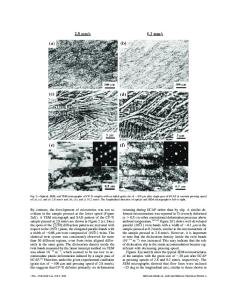Evaluation of Strain Rate During Equal-channel Angular Pressing
- PDF / 288,720 Bytes
- 8 Pages / 612 x 792 pts (letter) Page_size
- 82 Downloads / 334 Views
Strain rate is an important factor in plastic deformation because it determines the constitutive behavior of rate sensitive materials, e.g., dislocation density and flow stress evolution, deformation heat generation, etc. In the present study, the strain rate of workpiece materials during equal-channel angular pressing (ECAP) was evaluated by a geometric approach. The results were compared to those of the finite element analyses of a model ideally plastic material with various mesh sizes. The derived equation for strain rate is in reasonably good agreement with the results of the finite element method. The effects of the die geometry (a channel angle and a corner angle) were investigated. The strain rate during ECAP increases with punch speed and decreases with die channel angle, die corner angle, and the width of the workpiece. The relation obtained can be used for analytical calculations of the deformation, thermal, and microstructural evolution behavior of materials during ECAP. In particular, the size of the deforming zone and the effect of the finite element size are discussed.
I. INTRODUCTION
The evolution of the microstructure of metals during plastic deformation has been extensively studied over the last few decades.1,2 It is generally accepted that if metals are deformed at room temperature, average subgrain/cell size decreases with strain. Hence deformation processing can be a possible method for grain refinement of metals. In recent years, the severe plastic deformation (SPD) process was developed by Russian scientists as a new method of manufacturing bulk specimens with ultrafine grain structure.3 Not only do the SPD-processed materials show unique physical and mechanical properties inherent in ultrafine-grained materials, but they also have a number of advantages over nanostructured materials manufactured by other methods through powder processing. Among various SPD methods, such as multiple forging, torsion straining, accumulated roll bonding, and equal-channel angular pressing (ECAP), the ECAP process is a promising technique that involves large shear plastic deformation in a deforming layer of a workpiece by moving a specimen through a die containing two intersecting channels of identical cross sections that meet at a predetermined angle. This process, invented by Segal et al. in the beginning of the 1980s,4,5 has been the subject of intensive study in recent years due to its capability a)
e-mail: [email protected]
172
http://journals.cambridge.org
J. Mater. Res., Vol. 17, No. 1, Jan 2002 Downloaded: 19 Dec 2014
of producing large fully dense samples containing an ultrafine (or even nanometer-scale) grain size by repeating the process while maintaining the original cross section of the workpiece. Significant progress has been made in the analysis of the process itself as well as in the understanding of fundamental properties of the equalchannel-angular-pressed materials. Refer to a recent review for a state-of-the-art summary of this field of research.3 Figure 1(a) shows the principle of ECAP,
Data Loading...











